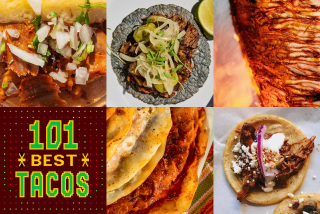Have You Had a Yuca Lately?
- Share via
Question: What is a yuca?
A) A starchy root vegetable popular throughout Latin America.
B) A stylish Cuban restaurant in Miami.
C) An acronym for Young Urban Cuban American (a Hispanic yuppie).
If you answered either A, B or C, you’re correct. Yuca is a long, slender tuber eaten throughout the Caribbean and Central and South America. It’s so popular among Cuban-Americans that it’s the namesake of one of the most fashionable restaurants in Miami.
The restaurant Yuca serves yuca fritters, yuca stew, yuca blinis with caviar, and even yuca doughnuts. Not bad for a vegetable whose very existence was ignored by most non-Hispanic Americans until recently.
Yuca is the root from which tapioca is made. Also known as cassava and manioc, it’s a slender, elongated root, four to 18 inches in length, tapered at both ends. The leaves of the plant look like marijuana; the roots grow in finger-like clusters. The rough, brown, bark-like skin harbors a flesh that is as white as bone. The texture is dry and starchy; the flavor is mild, almost bland, with a delicate buttery flavor.
Native to Brazil, yuca is grown throughout Latin America, the Caribbean, Africa, Asia and even Florida. Despite its relative blandness, it is an essential ingredient in much Latin American cooking. Nicaraguans dote on vigoron, a hearty appetizer of boiled yuca topped with pork cracklings and pickled cabbage. Brazilians combine yuca, shrimp, tomatoes and coconut milk to make a spicy stew called bobo.
Cubans are the undisputed masters of preparing yuca, transforming it into appetizers, desserts and everything in between. Yuca French fries and yuca chips are popular Cuban hors d’oeuvres. Boiled yuca with mojo (a garlicky vinaigrette) is a classic vegetable accompaniment to meats. Cuban pastry chefs make a dough from boiled, mashed yuca, which they roll into tubes, twist into figure-eights, deep-fry and soak in sugar syrup to make a doughnut-like dessert called bunuelos.
Alas, all yucas are not created equal. When buying this vegetable, look for firm, heavy roots covered with unbroken skin. Avoid tubers with cracks, soft spots, mold or an unpleasant or ammoniated odor. The flesh should be white--do not use yuca with brown spots or grayish or bluish veins. Unfortunately, you can’t judge the tuber by its exterior. When shopping in Hispanic markets, it’s not unreasonable to ask the produce man to cut one open for you. “I carry a small knife when I go shopping,” says Cuban cooking authority Maricell Presilla.
Yuca is available year-round, but it is relatively perishable. You needn’t refrigerate it, but try to use it within a few days of purchase. Miami chef Doug Rodriguez favors the yuca from Costa Rica, which is dipped in wax to prevent it from drying out. According to Presilla, commercial frozen yuca makes an acceptable substitute for the fresh. Look for yuca in Caribbean or Latin American markets or in the produce section of a large supermarket.
The most popular methods for cooking yuca are boiling and frying. Boiling transforms the root into a soft pulp that is delicious with butter. When deep-fried, the root becomes pleasingly crisp, a good foil for spicy sauces. Boiled or fried yuca should be eaten hot, as it becomes mealy at room temperature. According to Rodriguez, you can use yuca in any recipe that calls for potato. Keep in mind, however, that it contains more starch.
To prepare yuca for cooking, cut it into two-inch rounds. Remove the skin, using a paring knife. (Remove both the bark-like skin and pink layer underneath.) In large roots, you’ll find a fibrous center. This can be cut or scraped out before or after cooking. Cook yuca in boiling salted water to cover for 20 to 30 minutes, or until soft. Cuban cooks like to “shock” the root, adding a glass of cold water after the first crack appears in the center. The cold water is supposed to help spread open the fibers.
When frying yuca, parboil it first. Fry it in 375-degree oil for three to four minutes, or until crisp but not brown.
Yuca is relatively high in calories (about 135 per half cup). It’s a good source of iron and contains traces of calcium and niacin.
Yuca con mojo is a popular Cuban side dish, the Hispanic version of boiled potatoes. Mojo is a Cuban vinaigrette made with garlic and sour orange juice or lime juice. This is Hispanic comfort food, but you don’t have to be a native to enjoy it. Here’s how our Cuban housekeeper, Elida Proenza, prepares yuca con mojo.
ELIDA PROENZA’S YUCA CON MOJO
1 1/2 to 2 pounds yuca
Salt
Mojo
1 small white onion, very thinly sliced
Peel yuca with paring knife (cut in 1/2 if large). Cut into even 2-inch chunks. Bring 2 quarts salted water to boil. Add yuca and cook 20 minutes, or until cracks begin to appear in center. Add 1 cup cold water. Cook 5 to 10 minutes longer or until very tender. Drain well. Pull out any fibers from yuca.
Arrange yuca on platter or individual plates. Pour hot Mojo on top. Garnish with onion and serve at once. Makes 4 servings.
Note: To be strictly authentic, use sour orange (naranja agria), which tastes very similar to lime.
Mojo
2 cloves garlic, finely chopped
1/3 teaspoon salt or to taste
1/4 teaspoon freshly ground black pepper
1/4 cup lime juice or sour orange juice
2 tablespoons olive oil
Pound garlic to paste with salt and pepper in mortar and pestle. (Alternatively, garlic can be minced and mixed in ceramic bowl.) Stir in lime juice and correct seasonings. Just before serving, heat olive oil in small skillet and carefully pour into garlic mixture.
More to Read
Eat your way across L.A.
Get our weekly Tasting Notes newsletter for reviews, news and more.
You may occasionally receive promotional content from the Los Angeles Times.










